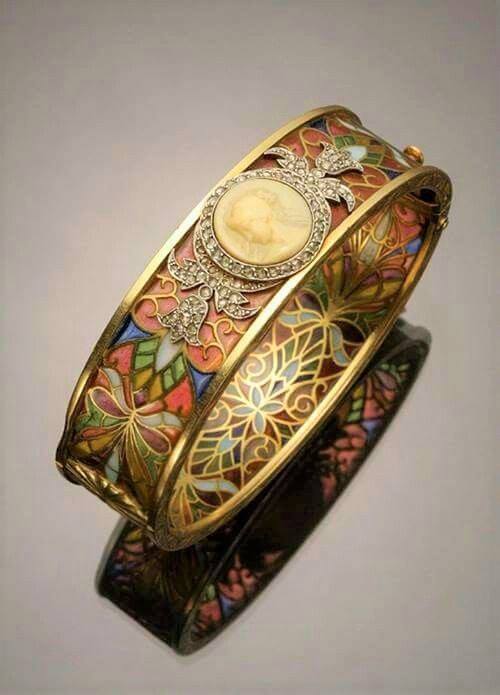petermorwood:caitlynlynch:the1920sinpictures: 1920 c. Just before the emergence of Art Deco, here is
petermorwood:caitlynlynch:the1920sinpictures: 1920 c. Just before the emergence of Art Deco, here is a last gasp of Art Nouveau design in this bracelet by Luis Masriera. It’s made of gold, colored glass, diamonds and cameo. From Art Deco, FB. aaaaa ‘colored glass’ doesn’t even come CLOSE, my friend. This is not like leadlighting. That is plique-a-jour (light-of-day) enamelling, on a curve, with multiple colors, in tiny ‘cells’ made out of gold wire no thicker than your fingernail (which in and of themselves would have been a stone cold bitch to make aaa they are so tiny and those joints are so perfect HOW DID HE DO THAT).Every. single. cell, has to be ‘hand-filled’ with wet enamel, which has a texture very much like watercolor paint, allowed to set, refilled until the surface tension holds, and then fired in a kiln at a very precise temperature and time, which is different for each color. And then the enamel shrinks back to the edges of the cell so you have to let it cool, refill, and then fire again. I’ve had to refill a single cell as many as four times to get color fill.Blues and greens are the easiest, so you do them first. You take the kiln to a slightly higher temperature, have a few more seconds of leeway before they go horribly discolored on you. Oh, and this is using a modern kiln with a precise, digital temperature controller, not whatever this dude had back in the 1920s which would have involved a lot of guesswork and standing by the kiln counting under his breath because enamel fires in SECONDS.Guess which colors are the hardest? That’s right, REDS. The colors this stunning bracelet is full of. I LOATHE working with reds. Ten seconds too long, five degrees too hot, and they’re ugly, black-flecked disasters that have to be dissolved out with acid, not incidentally trashing the other colours you’d spent forever on too. Yay.And when you’ve finally finished, having spend probably hundreds of hours getting all those tiny cells fired and filled? Time to sit down with a bowl of water and a hard grinding stone and grind every single one of them flat, my friend, because the enamel when properly filled actually domes up slightly. Yes, this part is still best done by hand, even today.Don’t forget to repolish your gold, making sure to get out all the scratches left by your glass-polishing stone, and set all those diamonds and the cameo! What’s that, you say? One of your glass cells fractured because you used a tiny bit too much pressure setting a diamond?Dear me. Time to UN-set all those stones and go back to the kiln again. Have a lovely time!‘Colored glass’, indeed. Hmph. And now think of what was involved in making something from the Sutton Hoo treasure with the tools available in 7th century England.Yikes. -- source link
Tumblr Blog : the1920sinpictures.tumblr.com
#jewelry#1920s fashion#medieval#medieval fashion
